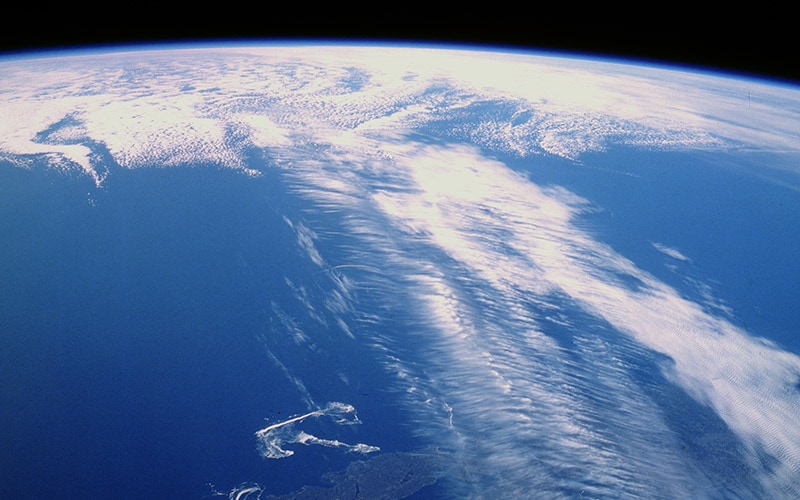What Exactly Is The Jet Stream?
What do the weather, air quality, and the speed of airline travel have in common? All of them are influenced by jet steams.

The term “jet stream” describes any current of fast-moving air in a planet’s upper atmosphere. Jet streams form where two masses of air of drastically different temperatures meet, such as where the chilly air from the polar latitudes collides with the warmer air coming up from the southern United States. Because cold air and warm air are very different in terms of air pressure, their collision creates a powerful wind.
Jet streams can be incredibly fast – sometimes more than 200 mph. They are generally very long – spanning up to 3,000 miles – but are only a few hundred miles wide and a couple of miles tall. They sit between six and nine miles above the Earth’s surface in a layer of atmosphere known as the tropopause, a transition layer that forms a buffer between the troposphere and the stratosphere.
On planet Earth, there are six major jet streams that flow west-to-east around the globe, three each in the Northern Hemisphere and Southern Hemispheres. There are two polar jet streams that flow near both the Arctic and Antarctic circle, two subtropical jet streams the flow about halfway between the poles and the Equator, and one on either side of the equator.
In general, though, when North Americans speak of “the jet stream” they’re referring to the northern polar jet stream, which passes over much of the northern and eastern United States as well as southern Canada. The actual path of this jet stream depends on the temperatures above and below it. Sometimes it travels close to the 49th parallel, the latitude that serves as the border between the United States and Canada. Sometimes, though, it wanders much farther south. Sometimes it takes a fairly direct path, and sometimes it meanders dramatically along its way.
The starker the difference in temperatures along the path of the jet stream, the straighter and more direct the path of the jet stream is, and the faster it goes. When there is less of a difference in temperature, the jet stream flows more slowly, and is more prone to taking a wild, undulating path. Large dips in the path of a jet stream are called Rossby Waves.
We saw this over the past winter, when a warming of the arctic circle allowed the jet stream to dip deeply into the southern US, bringing a very cold winter to the Eastern half of North America.
Jet Streams & Weather
Technically, jet streams do not cause weather patterns; they respond to them. However, the strength of the jet stream can influence what weather conditions occur where. A strong, fast jet stream can contain cold, high pressure air fronts, regulating temperatures on the other side. When the jet stream is weaker, however, it’s easier for cold air to push farther south. In addition to influencing the weather, the jet stream can also affect the air quality in a given area, carrying smog and pollution from heavily industrial areas into less populous areas that would otherwise have cleaner air.
The jet stream can also be pilots’ greatest friend or foe, depending on which direction they’re flying. Pilots flying east to west tend to avoid the jet stream at all costs, as it can work against an aircraft, creating drag that the airplane has to fight against. This slows down the plane and causes it to consume more fuel. Pilots flying west to east, however, often hitch a ride along the jet stream to gain more speed and consume less fuel. While this can be a real boon for airlines, it can also be dangerous.
Flying near the jet stream opens pilots up to the risk of encountering “clear turbulence,” that is turbulence that is not visible in the form of clouds. Clear turbulence is more dangerous than conventional turbulence because there’s no warning that it’s coming, so pilots can’t instruct passengers and flight attendants to remain seated. Clear turbulence is responsible for more in-flight injuries than other forms of turbulence.
Whether bringing us polar vortexes or helping us to fly the friendly skies, the jet stream is one of the most interesting, and influential, forces on the planet.

Jaime McLeod
Jaime McLeod is a longtime journalist who has written for a wide variety of newspapers, magazines, and websites, including MTV.com. She enjoys the outdoors, growing and eating organic food, and is interested in all aspects of natural wellness.






My Father told me how pilots in WW II discovered the jet stream going from Hawaii to the west coast. Sometimes the trip was much shorter and easier than other times.
If folks are interested, NOAA map of the jet stream looking down at the north pole:
http://squall.sfsu.edu/gif/jetstream_norhem_00.gif
Other jet stream maps here:
http://squall.sfsu.edu/crws/jetstream.html
I have been the jet stream daily for 6 months, and weekly for several years.
positive flow(hot air)negative flow cold air,creates power when trying to occupy the same space.
Very informative article, but there is one minor technical error. The headwind encountered by flying east to west does not create more drag, thence increasing fuel consumption. The headwind causes the aircraft’s groundspeed to decrease, thus increasing the time enroute, and the fuel consumed. It’s just the opposite west to east. Think of it like a river – a boater hitches a ride downstream, but has a slower go upstream. Thank you.
This article triggered a memory of my reading about an airliner in the 40’s, I think it was, flying in South America when nothing was understood about the jet stream. The pilot thought he was at his destination while flying over the Andes Mountains but was actually a very long way from it because of the head wind of the jet stream. The plane crashed in the mountains and was never found. That is, until decades later the wreckage emerged out of a melting glacier.